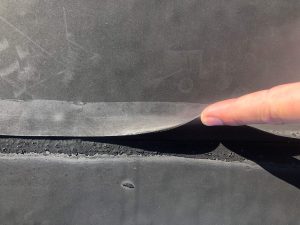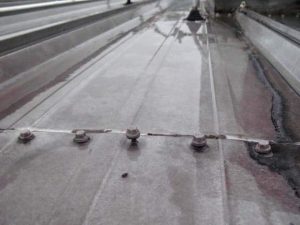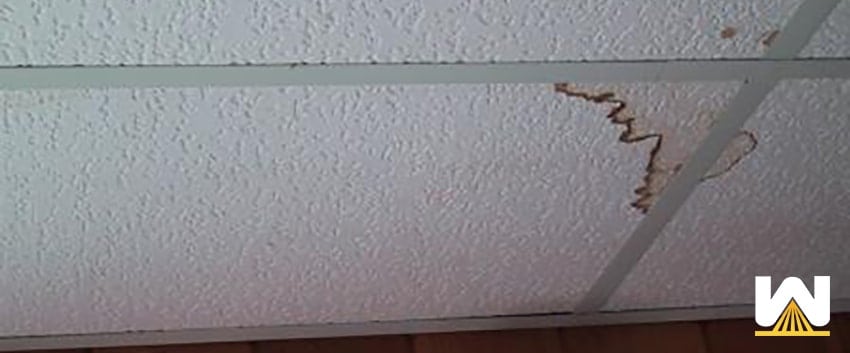So, you came into work today, and there you see it…a brown spot on your ceiling.
You’re probably thinking, “It’s not that brown,” or “It’ll never come all the way through”.
But what if I told you that noticing this problem and taking action NOW can potentially save you hundreds of thousands of dollars?
Now your ears perked up!
It’s like when you have a cold and it’s not going away, so you see a doctor to make sure it’s not something serious.
Word to the wise: those brown spots aren’t going anywhere.
And if you’re a building owner with brown spots on your ceiling, you could be in a similar situation.
In this article, we’ll tell you the first steps to take when noticing a roof leak.
The first step you should take when noticing a roof leak is to get a roof inspection
A roof inspection is performed by a professional roofing contractor to assess the current condition of your roof.
A roofing contractor will schedule a time to meet with you, ask you questions about your roof and your interior brown spots, and ultimately go up on the roof and perform an inspection.
A roof inspection will look at the condition of your:
- Deck, Insulation and Membrane
- Base Flashing
- Metal Edge
- Wall Coping
- Drains and Gutters
- Wall Surfaces
- Roof Slope
- Drainage Method and Standing Water
Once completed, you’ll be sent an inspection report with observations and recommendations. Pictures will be included to back up the observations.
So why should you even request a roof inspection?
You should request a roof inspection because you might identify a fixable, minor issue before it escalates into a major problem.
For example, say you request a roof inspection and after looking at a report, a roofing contractor tells you only 10% of your roof is saturated.
Your options are repair, or you can restore your entire roof.
Restoring your roof consists of removing the saturated/wet areas, replacing with like materials, and adding a protective coating over the entire roof.
A popular option is a Silicone Restoration Membrane, which can grant your roof a new 10-15-year warranty and create a seamless and waterproof layer.
Building owners choose to restore their roof because repairs are only a temporary solution. If a roof is allowing water in one area, there’s a good chance other parts of the roof are near the same stages of failure, which can lead to more repairs.
But let’s just say you don’t request a roof inspection
If you don’t request a roofing inspection and ignore the problem, every rainstorm after is going to damage your roof more and more.
At some point, you’re going to have water coming through the brown spots on your ceiling, or you’ll develop brown spots elsewhere, and you’ll be forced to call a roofing contractor.
After you get your inspection and look at the report, most likely you’ll find the saturation on your roof exceeds 25% of the entire surface.
At this point, repairs and restoration are no longer an option. The only option you’ll have is a complete tear off, which is bad for multiple reasons:
Reason #1 – A complete tear off costs 3-4x more than a roof restoration
A standard roof is around 20,000 sq. ft. Restoring a roof can cost anywhere from $2-4 per square foot. Let’s just use $3/sq. ft. as an example. So, a roof restoration will be around $60,000 (20,000 x 3), while a complete tear off (let’s use 3x more expensive as an example), will cost $180,000 (60,000 x 3).
$180,000 vs $60,000 is a $120,000 difference!
[and you thought when I mentioned “hundreds of thousands of dollars” in the intro, I was just blowing smoke; imagine the 50,000 sq. ft. roofs…]
Reason #2 – Your roofing project will also take longer to complete (increasing business interruption)
A roof restoration system can take anywhere from 8-12 days on a 20,000 sq. ft. roof. A complete tear off adds at least 2-3 days onto the project.
Reason #3 – All your torn off materials will contribute to landfills (bad for environment)
All the saturated/wet materials need to be collected, thrown into a dumpster and transported to a landfill.
Not to mention all the labor hours added onto a project.
This consists of money and materials being wasted…the definition of being non-effective.
Hopefully you’re getting it, we need to catch roof leaks early.
What are other signs your roof may be leaking?
If you have a rubber roof, pay close attention to the seams.
If you see any lost adhesion in the seams, it’s only a matter of time (and sometimes it happens within the next wind/rainstorm), before the seams aren’t adhered at all.
Here is a picture of a failing seam on a rubber roof:

Once this rubber seam loses just a bit more adhesion, it will create an entry point for water to enter the building.
And if one rubber seam is losing adhesion, there’s a good chance the other seams aren’t too far behind.
If you have a metal roof, pay close attention to lifted fasteners, signs of corrosion or rust and/or crimping between two panels.

These areas are all high-risk of creating an opening for water to enter your metal roof.
If you have a metal or rubber roof, set a reminder to go on your roof once a month and do a quick inspection.
If you’re ever concerned, call a roofing contractor. Most roofing contractors will do a roof inspection for free.
Of course, they are hoping you’ll use them when you’re ready to give your roofing project the green light, but you don’t have to.
In fact, collect a few different inspections and see what each roofing contractor says. If they all have the same discoveries and recommended actions, great! Use the roofing contractor you trust the most and get it done.
Last comments about noticing a roof leak
Going back to seeing the doctor. If you never would’ve went, who knows, maybe your cold escalated into pneumonia?
The same thing can happen to you and your roof.
If you ignore the first step of at least going on the roof and checking it out, you really are setting yourself up for financial disaster.
And if you do see signs of major (or even minor) issues, contact a roofing contractor and get a roof inspection.
No one likes to pay for something that could’ve been avoided.


